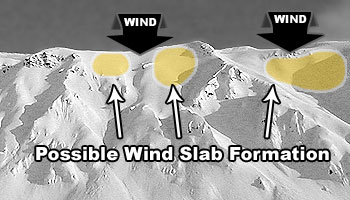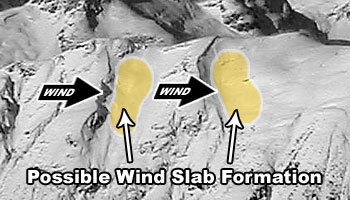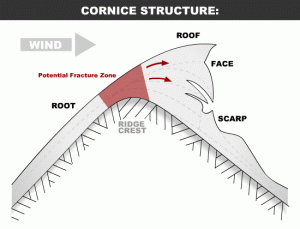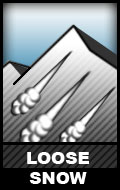Avalanche Danger Update
Avalanche danger is expected to remain elevated through at least Tuesday due to strong winds and precipitation (potential for a few to several inches of snow in the alpine). The forecast weather will stress existing persistent slabs, and build fresh wind slabs.
Last week the Western Chugach Mountains of Chugach State Park were subjected to significant stress, primarily from strong winds that blew for days and wind loaded leeward terrain above ~2500′ with trickles of precipitation that overcame the downslope effect and actually made for significant accumulations (over the course of the week) in some upper elevation areas.
Avalanche Problems:
Natural wind slab avalanches are possible, and human triggered wind slabs likely, on steep (35*+) and leeward upper elevation terrain (primarily top-loaded slopes below ridges and cross-loaded gully sidewalls). These wind slabs may be up to D2 in size (large enough to bury and kill a person), and will be especially dangerous where the debris is channeled into a “terrain trap,” which greatly increases the consequences of getting caught in a slide, or there is exposure to a dangerous fall.
If you get out in the mountains this week, be on the lookout for red flags of wind slab danger: recent avalanches, shooting cracks (cracks that radiate out from your feet when pressure is applied to the snow), and heavily wind loaded terrain that looks bulbous and/or feels hollow. Wind slab danger may be sussed out with pole probing and quick hand pits. Convexities are likely trigger points.
Natural and human triggered persistent slab avalanches up to D2.5 are possible on steep (35*+) upper elevation (2500’+) terrain. These avalanches are expected to be most susceptible to human triggering where they’ve been stressed by recent wind loading and there is a “sweet spot” trigger point where the slab is thinner, and the “stress bulb” emitted by a human more readily penetrates to the buried persistent weak layer.
Buried persistent weak layers responsible for the persistent slab avalanche danger primarily exist in two forms: faceted snow around buried melt-freeze and rain crusts, and large basal facets and depth hoar near the ground.
Triggering a persistent slab avalanche could be catastrophic. While a relatively low probability avalanche problem, they could be extremely high consequence. They are expected to behave like hard slabs, meaning they could allow a trigger to get into the middle of the slab before breaking above and around the trigger making escape especially difficult.
If you’re venturing out into the mountains this week, understanding the persistent slab avalanche problem will take thorough stability assessment and snowpack analysis. Dig a full snowpit, search for and identify buried weak layers, and conduct a stability test like the ECT to better understand slab reactivity. Be on the lookout for red flags like recent avalanches, whumphing (i.e. collapsing), and shooting cracks.
Cornices have grown from the recent strong winds and precipitation, and are expected to be especially prone to failing and falling this week (both naturally and from human triggers). Give corniced ridges a wide berth; they can break off much further back than expected (even beyond where they’re overhung). Never approach the edge of a snow-covered ridge, unless you’re sure it’s not corniced. A cornice fall itself is dangerous, but can also trigger a large avalanche as it “bombs” the slope it falls onto.
Natural and human triggered loose snow avalanches (aka “sluffs”) are possible on steep (40*+) upper elevation (3000’+) terrain sheltered from the wind (where the snow isn’t wind-packed and remains loose and unconsolidated). While loose snow avalanches will only be D1 in size, they could trigger a larger slab if they build significant mass as they descend. They can also be dangerous around terrain traps and areas with fall exposure; while they may not be big enough to bury a person they could sweep one off their feet. If you find yourself on steep terrain with loose snow this week, practice effective “sluff management” and be mindful of exposure and terrain traps.
***
Finally, please keep in mind that many popular trails and areas in Chugach State Park are exposed to and cross potentially dangerous avalanche terrain. Trails like Powerline (from Glen Alps) and Falls Creek (on Turnagain Arm) are exposed to numerous avalanche paths that regularly avalanche naturally. You could be caught, buried, and killed in an avalanche even if you’re on flat ground in the lower or mid elevations: BE MINDFUL OF AVALANCHE TERRAIN ABOVE YOU!
If you recreate in the mountains during the snow season please make sure you have at least a basic level of avalanche awareness that enables you to identify and avoid potentially dangerous avalanche terrain and paths, practice “safe travel protocols for avalanche terrain,” and effectively use avalanche rescue equipment (beacon, shovel, probe).
When you head out for an adventure, leave a “trip plan” with a friend or family member staying in town so they could initiate a response in the event of an accident.
*Click the hyperlinks and icons throughout this page for further learning*







